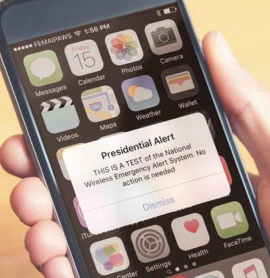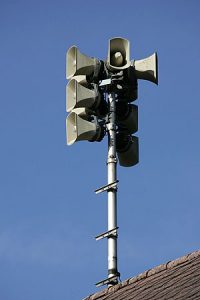September 20th Test Will Appear as an Actual Emergency Message
 Many of us are used to the required weekly and monthly test alerts that periodically interrupt broadcast radio and television programming with those jarring tones. Do not be alarmed when a similar system test is conducted one week from today, although on a much larger scale, coordinated by the Federal Emergency Management Agency (FEMA) in conjunction with the Federal Communications Commission (FCC).
Many of us are used to the required weekly and monthly test alerts that periodically interrupt broadcast radio and television programming with those jarring tones. Do not be alarmed when a similar system test is conducted one week from today, although on a much larger scale, coordinated by the Federal Emergency Management Agency (FEMA) in conjunction with the Federal Communications Commission (FCC).
On September 20, 2018, FEMA and FCC will conduct a nationwide test of the Integrated Public Alert and Warning System, known as IPAWS.
Although this test will interrupt radio and television programming like the regular Emergency Alert System (EAS) tests, the messages will be delivered to broadcasters through next-generation alerting infrastructure rather than over the airwaves. Because this exercise make use of that new alerting technology, the alert will also trigger notifications on Wireless Emergency Alert (WEA) compatible cell phones.
The widespread national test is intended to help both alert providers as well as recipients ensure that the system functions normally from end to end so that important information can be received in a timely fashion in the event of an actual emergency.
The WEA portion of the test commences at 2:18 p.m. EDT, and the EAS portion follows at 2:20 p.m. EDT.
The WEA test message will be sent to cell phones that are connected to wireless providers participating in WEA. This is the fourth EAS nationwide test and the first national WEA test. Previous EAS national tests were conducted in September 2011, 2016 and 2017 in collaboration with the FCC, broadcasters, and emergency management officials in recognition of FEMA’s National Preparedness Month.
“The tests that you usually hear are typically a part of the over-the-air broadcast EAS and NOAA Weather Radio systems,” a representative of alerting equipment manufacturer, Gorman-Redlich, told Louisville Dispatch. “Those tests tend to be for a relatively small geographic area and affect only broadcast outlets. This time, the test targets a nationwide audience, with alerts being sent to all broadcasters at once by internet and satellite signals and to individual cell phones by their carriers.”
The message heard on radios and televisions during this nationwide test will be similar to regular monthly EAS test messages with which the public is familiar and will include a reference to the WEA test: Continue reading
 In conjunction with National Preparedness Month, Gov. Matt Bevin has proclaimed September as Preparedness Month in Kentucky.
In conjunction with National Preparedness Month, Gov. Matt Bevin has proclaimed September as Preparedness Month in Kentucky.
Kentucky Emergency Management urges Kentuckians to “BE AWARE – BE PREPARED – HAVE A PLAN – MAKE A KIT.”
Kentuckians face threats to their safety and property throughout the year; from tornadoes, flooding, straight line winds, lightning, winter storms, man-made hazards, to daily emergencies. Every household and every business should be prepared to face these challenges at any given time. Disasters can occur at anytime, anywhere in Kentucky.
As we have all seen recently with Hurricanes Harvey, Irma, Jose and now impending Maria, preparedness can make the difference of saving your life or your family. Supplies such as water, non-perishable food, flashlights and batteries, radios and first aid kits are easy to store, and can be lifesavers when a crisis hits. A communication plan with family, friends and neighbors is also very important.
Michael Dossett, director of Kentucky Emergency Management (KYEM) stated, “During National Preparedness Month, the theme, ‘Disasters don’t plan ahead – You Can!’ is a great opportunity to remind our family, friends and neighbors of the importance of planning ahead, highlighted by the recent losses of Hurricanes Harvey and Irma.” Dossett went on, “ask yourself, what would you do in the next two hours, next two days and next two weeks following a disaster event to ensure the survival of your loved-ones?”
PLANNING FOR DISASTER: “BE AWARE – BE PREPARED – HAVE A PLAN”
Be Aware:
- Stay informed about risks in your communities and monitor weather forecasts.
- Own and monitor a battery backed-up or crank-type NOAA Weather Alert Radio. During threatening weather, stay tuned to your local broadcast stations.
- Discuss conditions with family members, and know their locations during dangerous weather.
Be Prepared:
- Discuss known risks with family members and neighbors.
- Develop and review your emergency plan periodically and update of necessary.
- Assemble an emergency kit(s) and refresh periodically. A kit should have enough food, water and medications for each family member for five days.
- Drill: practice your plan with household members.
Have a plan:
- Share your plan with others, including friends or relatives in another region or even another state
- Medications – prepare a list of all prescription drugs.
- Utilities – Written instructions for how to turn off electricity, gas and water; if authorities advise you to do so. (Remember, you’ll need a professional to turn them back on.)
- Shelter – Identify safe locations within and outside your residence.
- Contacts – Written contact information for relatives, neighbors, utility companies, employers/employees and local emergency contact telephone numbers.
- Evacuate – Predetermine evacuation routes. Identify where you could go if told to evacuate. Choose several places, such as a friend or relative’s home in another town, a motel or shelter.
- Children – Make backup plans for children in case you (or they) can’t get home in an emergency.
- Vehicles – Keep jumper cables in all vehicles at all times.
- Maintain at least a half tank of fuel in vehicles.
- Move vehicles away from under trees during possible wind events.
- Keep an emergency kit in all vehicles.
- During winter months, keep a blanket and bag of kitty litter in the trunk.
- Medications – prepare a list of all prescription drugs.
- Pets – have at least a 3 day supply of food and water for each pet. Have carriers, a collar or harness with ID tag, rabies tag and a leash; familiar items such as treats, toys and bedding can help reduce stress for your pet.
- Share your plan with others, including friends or relatives in another region or state.
Make an emergency kit:
- First aid kit and essential medications (to include prescription medicines).
- Canned food and can opener
- At least three gallons of water per person
- Protective clothing, rainwear and bedding or sleeping bags
- Battery or crank powered radio, flashlight and extra batteries or crank recharging stations that are capable of recharging cell phones, tablets, laptops, etc.
- Waterproof matches and candles
- Local phone book
- Special items for infants, elderly or disabled family members
- Extra set of car keys
- Cash – as much as you can afford!
For additional preparedness information, visit www.ready.gov and Kentucky Emergency Management at www.kyem.ky.gov. Follow @KYEMPIO on Twitter, like us on Facebook, and sign up for text alerts.
See Governor’s proclamation at https://kyem.ky.gov/Documents/septemberpreparednessmonth.pdf.
Statewide Tornado Safety Drill Is Feb 23 – 10:07 A.M. EST

Photo: Roland Zumbühl
Governor Matt Bevin has signed a proclamation designating Feb 22 – 28 as Severe Weather Awareness Week in Kentucky. Severe weather is Kentucky’s most common threat, as evidenced by the four weather-related, federally-declared disasters during 2015.
“As evidenced by the severe weather events in the first two months of this year; preparedness efforts of our county EM partners, local emergency responders and citizen outreach, made a dramatic difference in ensuring no injuries or loss of life occurred during these responses”, said Michael Dossett, Director of Kentucky Emergency Management. Dossett went on to say, “Testing your plan during Awareness Week, whether by family members or with your co-workers, ensures we are all ready for the next weather hazard that may challenge the Commonwealth”.
As part of severe weather awareness activities, a statewide tornado drill will be conducted in conjunction with the proclamation.
At approximately 10:07 a.m. EST, Tuesday, Feb 23, the National Weather Service (NWS), in partnership with Kentucky Emergency Management (KYEM), the Kentucky Weather Preparedness Committee and Kentucky Broadcasters Association will issue a test tornado warning message.
Across Kentucky, outdoor warning sirens will sound, weather alert radios will activate, and television and radio stations will broadcast the alert; allowing the public the opportunity to practice tornado safety.
The broadcasted test message will emphasize this is only a test of the alert system. During the test alert all Kentuckians, businesses, hospitals, nursing homes, educators and government agencies are encouraged to participate in the tornado drill and update their emergency plans.
As part of Severe Weather Week activities, Kentucky Education Television (KET) will host the popular live viewer call-in show, “Severe Weather – Staying Safe”. A panel of weather experts field questions from the general public. Callers will be registered to receive one of five NOAA Weather Alert Radios which will be awarded at the end of the show. The show will air live on Monday, Feb 22 at 10:00 p.m. EST. More information is available here.
Being prepared for severe weather starts with identifying threats and risks. The first step for each citizen is to become weather-ready by knowing what types of weather hazards that can affect where they live and work, and how the weather could impact them and their family. Citizens should check local weather forecasts regularly, get a NOAA Weather Radio, and sign up for alerts from local emergency management officials. Severe weather comes in many forms and emergency planning should consider the possibility all types of local hazards. Continue reading
 Weather
Weather Traffic
Traffic @LouisvilleDispatch
@LouisvilleDispatch @LouisvilleDisp
@LouisvilleDisp Subscribe
Subscribe